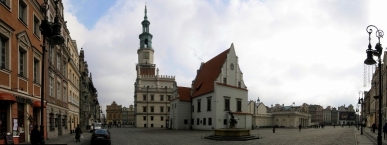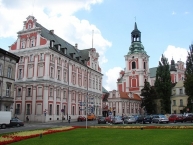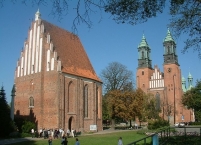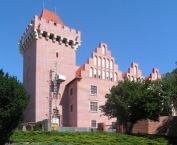Poznań Old Town
Worth visiting
Added on 02 Oct 2016,
last edited by biroto-Redaktion on 02 Oct 2016
Nearby cycle routes and tours
| Route name | Type | Dist. to route |
|---|---|---|
Route | 0,1 km | |
Route | 0,9 km | |
Route | 0,9 km | |
Tour | 0,1 km | |
Tour | 0,1 km |
![]()
Please wait - map data are loading
Type of sights
Old town
Name and address
Poznań Old Town
PL-60-101 Poznań
GEO-data
Geodetic coordinates
52.40∎∎∎∎ 16.93∎∎∎∎
Elevation
57 m
Communication
Information about copyright | |
|---|---|
Rights owner | |
Rights characteristic / license | by-sa: CREATIVE COMMONS Attribution-ShareAlike |
Link to the description of the license | |
Image taken over from | https://commons.wikimedia.org/wiki/File:Stary_Rynek_w_Poznaniu_widok1.JPG |
Image has been uploaded | by biroto-Redaktion on 02 Oct 2016
|
Information about copyright | |
|---|---|
Rights owner | |
Rights characteristic / license | by-sa: CREATIVE COMMONS Attribution-ShareAlike |
Link to the description of the license | |
Image taken over from | https://commons.wikimedia.org/wiki/File:Kompleks_Jezuicki_Poznań_RB1.JPG |
Image has been uploaded | by biroto-Redaktion on 02 Oct 2016
|
Information about copyright | |
|---|---|
Rights owner | |
Rights characteristic / license | by-sa: CREATIVE COMMONS Attribution-ShareAlike |
Link to the description of the license | |
Image taken over from | https://commons.wikimedia.org/wiki/File:Ostrów_Tumski_Poznań_RB1.JPG |
Image has been uploaded | by biroto-Redaktion on 02 Oct 2016
|
Information about copyright | |
|---|---|
Rights owner | |
Rights characteristic / license | by-sa: CREATIVE COMMONS Attribution-ShareAlike |
Link to the description of the license | |
Image taken over from | |
Image has been uploaded | by biroto-Redaktion on 02 Oct 2016
|
Poznań (German: Posen) is the largest city in Greater Poland, in the west of Poland, and one of the largest metropoles in the whole country. Situated roughly equidistantly between Warsaw and Berlin, it serves as a major economic hub, and a centre for industry and commerce. The Poznań International Trade Fair grounds host the most important trade fairs and exhibitions in Poland, making Poznań an important business destination, but the city has plenty of history and attractions to share besides that. Its relative compactness and easy access by road, rail and air make it a convenient tourist destination for visitors to Central Europe.
Understand
Poznań is a town steeped in history, as it was the first capital (with Gniezno ![]() ) of Poland and seen by many as the birthplace of the Polish nation. Today it is a diverse and vibrant town, with much to divert the traveler. It has a stunningly rejuvenated central square, thriving night-life, fascinating museums and many attractions in the surrounding area. For train buffs, Poznań is the home of Europe's last surviving steam-hauled passenger service. With a strategic position on the Berlin – Moscow train line, Poznań will be for many their first experience of Poland.
) of Poland and seen by many as the birthplace of the Polish nation. Today it is a diverse and vibrant town, with much to divert the traveler. It has a stunningly rejuvenated central square, thriving night-life, fascinating museums and many attractions in the surrounding area. For train buffs, Poznań is the home of Europe's last surviving steam-hauled passenger service. With a strategic position on the Berlin – Moscow train line, Poznań will be for many their first experience of Poland.
See
Ostrów Tumski (Cathedral Island), famed as the spot on which Poznań was founded, is a quiet island, with a permanent population consisting mostly of bishops, priests and monks. It was supposedly here that the town was founded, after three brothers Rus, Lech and Czech met here after not seeing each other for years (poznać being Polish for 'to meet'). It is also the spot where Poland adopted Christian baptism in 966 and where the first church (still existing Poznań Cathedral) of polish territories was built (968). The island is accessible from the centre or Old Town by trams 4, 8 and 17 and bus 63 (other lines, not really useful for tourist are 67 and 83). The cathedral is open for visitors every day from 8AM to 4PM-7PM (depending on the day), but is closed for sightseeing during services (esp. Sundays). Admission : €0.70.
- ⊙St. Peter's and Paul's Cathedral, Ostrów Tumski 17, Poznań. St. Peter's and Paul's Cathedral - the first Polish cathedral and the only one between years 968 and 1000. Burial place of 8 polish dukes and kings from the Piast dynasty - original graves from 10th and 11th cent. of Mesko I and his son Boleslaus the Brave preserced in the cellar; as well as the baptism bowl - a probable baptism place of Duke Mesko I. In the cathedral pay attention to the chain of chapels around the main aisle, not touched by bombings in 1945 - the most precious ones are: the Golden Chapel (which a present memorial place of Mesko I and Boleslaus the Brave - in the sarcophagus on the right-hand side) and the Holy Cross Chapel. (updated Oct 2016)
- ⊙ The Our Lady Church - built in late Gothic style (approx. 1430), not very significant for its present shape and values, but important for its role in the 10th century, when in the place the duke's palace and a small chapel were built. The chapel was probably erected one year before the official baptism of Poland. The interior (due to archaeological excavations) is closed for visitors.
- The Archbishop's Palace - built at the same time as the cathedral, but its present shape comes from the 2nd half of 18th cent. It is closed to visitors.
- ⊙ The Bishop Lubrański University - the second oldest high school in Poland, founded by bishop John Lubrański in 1518. At the present - the Archdiocesan Museum.
- Psalter House was erected in the beginnings of 16th cent (by Bishop Lubrański) as a rehearsal-place for psalter singers. They were due to sing the David's Psalms in the Cathedral the whole day round. It is now used by Christian associations.
- canonries - mostly from 18th and 19th cent, built for noble priest working for the Poznań Cathedral and Archbishop.
Stary Rynek, the old town square, one of the finest in Europe. This is the centre of old, medieval Poznań, and has been superbly rebuilt after severe destruction in World War II. Cafés and bars line the square and it is a superb spot for ordering a drink and watching the world go by.
- ⊙Town Hall, Stary Rynek 1, Poznań. The museum is open M,Tu,F 10AM-4PM, W noon-6PM and Su 10AM-3PM. The Town Hall is the centerpiece of the Rynek. It was built in the a Gothic style in the first years of the 14th century. It was later rebuilt in Renaissance style by Giovanni Battista di Quadro from Lugano. It is said to be the most beautiful non-church renaissance building north of the Alps. The building houses the Historical Museum of Poznań (originally the headquarters of municipal powers and the city court), displaying exhibitions about the history of the city from the 10th century to the present day. Two things to watch out for here are the ornately decorated Great Entrance Hall and the mechanical goats which appear from the roof of the building each day at noon to butt their heads together a dozen times. €1.50. (updated Oct 2016)
- ⊙The City Church of St. Stanislaus and Our Lady - opened in 2007 after total refurbishment, one of the most beautiful baroque churches in Poland. It was built as a Jesuits' church; it is now the parish church for the Old Town. Many tourist come here for the sounds of its organs, built here in the 1870s by one of the most famous organ masters of that time: Friedrich Ladegast from Wesenfels (Germany). The organs can be heard during services (regular on Sundays and on weekdays: 3 or 4 in the morning and 1 in the evening) and during organ concerts (each Saturday, 12:15, entrance free). Entrance: €1,10 (2009).
- ⊙The former Jesuits' College - an old Jesuits' school build by the monk in the same period, as the neighboring church, now houses the City Office - so it's possible to get in to see the interiors, but only halls and corridors. In the early 19th century is was the quarters for emperor Napoleon I during his march toward Moscow. Few years later - the concert place for Frédéric Chopin (his original instrument is still exhibited in Poznań in the Museum of Musical Instruments - see below). In front of the City Office is the monument of two goats - the symbol of the city.
- ⊙King's Castle, Św. Marcin 80/82, Poznań, ☎ +48 61 646 5272. 09:00–22:00. The King's Castle (Zamek Cesarski) - rebuilt by King Przemysł II in 1290s, but erected by his father, Duke Przemysł I as a duke's residence for Poznań county. The only remnants of the original building are the foundations, and - what tourists mostly look is the newer part of the building dated from the second half of 18th century. Now it houses the Museum of Applied Art and from the walls you can watch the panorama of the Old Town. Poznań King's Castle was the place of the Fist Prussian Homage in 1492 (however more famous is the second one presented on famous picture painted by Jan Matejko). The hill was also the place, where the arms of Polish first dynasty (Piasts) - the White Eagle - became the official national symbol. (updated Oct 2016)
- ⊙The Franciscan Church - it's a rather typical church from the turn of 17th and 18th cent, but is really worth coming here at least for a few minutes for its beautiful paintings on the vaulting and wood carvings created by two ingenious monk - brothers Adam and Antony Swach from the Czech territories. More religious visitors come here for the Sanctuary of Our Lady of Incessant Help - the Lady of Poznań (the picture in left side-aisle). The undergrounds of the church house two Models of Old Poznan.
- The Gorka Palace - the Gorkas were a famous late-medieval noble family in Poznań and erected their palace in mid 15th century, later rebuilt in 16th in Renaissance style (a marvelous portal from the eastern side). The palace houses the Archeological Museum (see below).
- ⊙The Holliest Blood Church - on Żydowska (Jewish) street, its erection is connected with a legend about desecration of the host done by a group of Jews. During services the priest stands backward to the people, and the church is used both by Roman Catholics and Greek Catholics (service each Sunday at noon in Ukrainian).
Środka district - located just few minutes from the Cathedral Island, it was a merchants' and craftmen's district working for the duke or king court in first half of 13th century, as the Cathedral Island had become overpopulated. The name come from the Polish name "Środa" (Wednesday), as weekly markets took place on Wednesdays.
- ⊙St. Margaret Church - late-Romanesque church (with some Gothic features) in the middle of Środka Market Square, nowadays a side-church for the cathedral parish. It's pretty hard to get inside, unless you come approx. a quarter before or after services.
- ⊙The church of St. John of Jerusalem - the first building on Polish territories built with bricks (before only wooden or stone building were erected) around the year 1188. The church was erected for the Johnnites order, who were running a hospital for the poor people nearby. The entrance is free, but as well limited to moments before or after services. This is also the only place in the city, where holy masses for dead people take place.
You can get from the Cathedral Island to Środka district using a pedestrians and cyclists' bridge, bearing the name of bishop Jordan (968-982), who was the first bishop of Poznań and Poland.
Just behind Środka a recreational area at the banks of Malta Lake start. They are 3 km away from the centre and include: an artificial skiing slope, an all-year-round tobogan slide, bike rental, ZOO (the biggest one in Poland), walking and jogging areas, a rollerskating track (5,5 km). The zoo is linked with the Środka district by narrow-gauge line, working from spring till autumn on workdays every hour, on weekends - every 30 minutes. Details : [3] (Polish only). Tickets - appr. €1.5, for kids €1, family tickets €4
The Emperor's district. The main building here is the Emperor's Castle, erected 1905-1910 by Franz Schwechten, the Berlin court architect of German emperor Wilhelm II. The huge neo-Romanesque building, which alludes to medieval constructions, was officially opened by the Emperor personally. It was the seat of Polish President in the inter-war period and Hitler's residence during WW2, when it was remodeled under the Albrecht Speer. The dominating element of the building is the Tower, originally 74-m high, after World War II was lowered (due to the damage in the lat period of the war) by approx. 20 metres. In the Rose Courtyard (opposite site to the main entrance) one can find a fountain modeled on the 13th century lions fountain in Allhambra (Spain). The castle houses the Castle Culture Centre, the Animation Theatre and many other institutions. It's also a place of many exhibitions, meetings, concerts and festivals.
- The system of forts surrounding Poznań in 19th century, all located nearby former round-road, just few km from the nowadays centre. Most of them are in poor technical state and are used for many (not really historical) purposes. Anyway it’s worth going to Fort VII (Polska str, accessible from the centre by trams #2, #17 and #18 to the final Ogrody stop, from the a short walk), where the Museum of Martyrology is located. The sightseeing of some forts on your own can be simply dangerous!
- A very unusual monument os. Stary Marych, at the very beginning of Półwiejska Str. (a shopping pedestrian zone), which is probably the only monument in the world of a man walking with a bike (all other cyclers ride). The Monumemo is dedicated to Stary Marych (Old Marych), a fictitious person, who features in local newspapers or in local radio stations (from 1983), and all his speeches about the actual problems are written (and read) in local Poznań dialect. It’s also the only monument of local dialect in Poland.
- The nature reservation "The Morasko Meteorite” – one of only two places like that in Europe (the second one is in Estonia) – a system of 7 craters left after a meteorite fall several thousands years ago. The name ‘Morasko’ comes from the suburban district placed approx. 1 km away.
Most of this attractions can be found on The Royal-Imperial Route in Poznań ![]() . This is a tour for tourist who would like to get to know better the history and culture of Poznań.
. This is a tour for tourist who would like to get to know better the history and culture of Poznań.
- ⊙Citadel Park, Wzgórze Cytadela. A fortress was built here by the Prussians in 1828; it was destroyed during fighting in 1945. It contains a cemetery for the Russian, Polish and British soldiers who lost their lives here.
Museums
- National Museum in Poznań. Has several branches throughout in the city:
- Painting and Sculpture Gallery , al. Marcinkowskiego 9, ☎ +48 61 856 8000, Tuesday – Saturday 10AM-5PM, 12 zł, free Saturday. This museum has a prominent collection of Italian, Spanish and Polish art. Many paintings have accompanying explanations in English.
- ⊙ Museum of the History of Poznan - Stary Rynek 1, ☎ +48 61 852 5316, [4] - in beautiful and original (not damaged during World War II) interiors of Poznań Town Hall, shows objects and documents from the whole city history; from 10th century till present day. Open Tue-Thur 9-15, Fr 12-21, Sat-Sun 11-18. Admission 7 zł. Saturday admission free.
- Musical Instruments Museum, Stary Rynek 45-47, ☎ +48 61 852 0857, [5] Tuesday – Saturday 11AM-5PM, Sunday 11AM-3PM, 7 zł. With 2000 items from all over the world, this is the only exhibition of its kind in Poland. It also has an extensive collection of Chopin memorabilia.
- Applied Arts Museum, Góra Przemysła 1, ☎ +48 61 852 2035. Open Tu,W,F,Sa 10AM-4PM, Su 10AM-3PM. Displays crafts, furniture, precious metals and glassware. Admission 7 zł, free Saturdays. Closed for renovation till November 2012.
- ⊙Archaeological Museum, Ul. Wodna 27, ☎ +48 61 852 8251. 10AM-4PM Tuesday – Friday, 10AM-7PM Saturdays, noon-5PM Sundays. With 42,432 artifacts, this is a large and fascinating museum. It specializes in the archeology of Wielkopolska and Egypt
 . admission: 8 zł (free Saturdays), English guide 70 zł.
. admission: 8 zł (free Saturdays), English guide 70 zł. - ⊙The Museum of Poznań Uprising 1956, Ul. Św. Marcin 80/82. Tu-F 10-17, Sa-Su 10-15. Placed in the interiors of Emperor's Castle shows exhibits connected with the Poznań workers' protest against the communist system in June 1956. On the exhibition there are photos of attendants and their personal belongings, and historical sources about the anticommunist opposition between 1945-1989. An interesting thing is a reconstructed tram, used by Protestants as a barricade. admission 4 zł, reduced 2 zł (free Saturdays).
- ⊙Literary Museum of Henryk Sienkiewicz, Stary Rynek 84, ☎ +48 61 852 2496. Open M-F 10AM-5PM. Sienkiewicz, who won the Nobel Prize for Literature in 1905, is best known for his work Quo Vadis?, an epic on early Christians in the Roman empire. He is Poland's most celebrated novelist, and this is the most extensive collection of items about his life and works. admission €0.70.
- ⊙Archbishopric Museum, Ul. Lubrańskiego 1, ☎ +48 61 852 6195. Placed in the former Lubrański Academy - the second oldest (after Kraków
 ) higher school in Poland. The exhibition shows church art, mostly from the Greater-Poland region, from early Middle Ages to present times, coffin portraits and a Treasury. Some interesting exhibits: baptism clothes of the Polish King Jan III Sobieski and a sword (given to the first Poznań bishop Jordan by the Pope Urban IX), used - according to the tradition - by St. Peter to cut off the ear of o Roman soldier short after Christ's death.
) higher school in Poland. The exhibition shows church art, mostly from the Greater-Poland region, from early Middle Ages to present times, coffin portraits and a Treasury. Some interesting exhibits: baptism clothes of the Polish King Jan III Sobieski and a sword (given to the first Poznań bishop Jordan by the Pope Urban IX), used - according to the tradition - by St. Peter to cut off the ear of o Roman soldier short after Christ's death. - Motoring Museum, Rondo Kaponiera (entrance in the Kaponiera roundabout underground walkway), ☎ +48 61 847 6359. Tuesday – Sa 10AM-4PM (closed Thursdays), Sundays 10AM-3PM. Run by the Wielkopolska Motoring Club, features a range of vintage and notable vehicles. admission €0.90.
Useful
Inside the range of 4 km:
Information about copyright | |
|---|---|
Rights characteristic / license | by-sa: CREATIVE COMMONS Attribution-ShareAlike |
Link to the description of the license | |
Input taken over from: |
Wikivoyage contributors, 'Poznań', Wikivoyage, The FREE worldwide travel guide that anyone can edit, 28 August 2016, 11:23 UTC, <https://en.wikivoyage.org/w/index.php?title=Pozna%C5%84&oldid=3040900> [accessed 2 October 2016] |
taken over / edited on | 02 Oct 2016
|
taken over / edited by |
|
Nearby cycle routes and tours
| Route name | Type | Dist. to route |
|---|---|---|
Route | 0,1 km | |
Route | 0,9 km | |
Route | 0,9 km | |
Tour | 0,1 km | |
Tour | 0,1 km |
Added on 02 Oct 2016,
last edited by biroto-Redaktion on 02 Oct 2016




